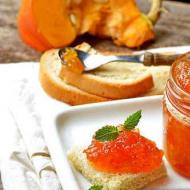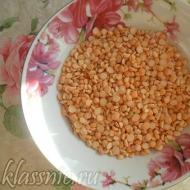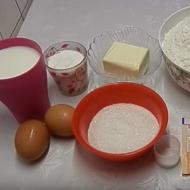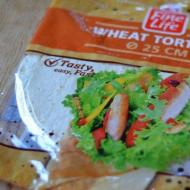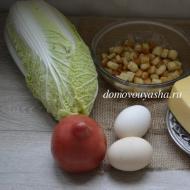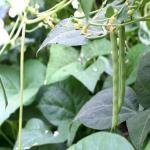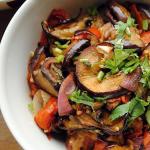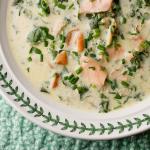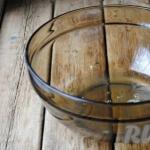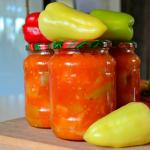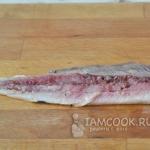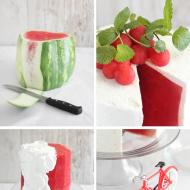
Prepare pilaf at home. How to cook pilaf correctly: step-by-step cooking recipes. The secret ingredient of pilaf
If you have ever tried real Uzbek pilaf, you will never forget its spicy aroma and unique taste. The recipe for making pilaf at home is not at all complicated.
How to cook pilaf correctly
Pilaf is an ancient national dish of Transcaucasia, the Middle East, and Asia. There are a lot of options for preparing this dish. However, eminent chefs assure that if several people simultaneously prepare pilaf using one recipe, everyone will still end up with a dish with different tastes.
How to cook pilaf correctly, what is the secret of Uzbek pilaf? Especially for our readers, we have put together the most important recommendations that will help you create a small masterpiece of great art called pilaf.
Secret 1 - Technology for proper preparation of pilaf
One of the main secrets of ideal pilaf is not the composition of the products used, which is also not unimportant, but the method of its preparation itself. Mainly, the taste and aroma of the dish depends on the correct combination of two main components of pilaf: rice and meat base (zirvak). Sometimes wheat, corn, and peas are used to prepare this dish instead of rice. However, in any case, in order for the pilaf to absorb all the tastes and aromas, the grains in the dish are not boiled, but stewed (simmered).
Secret 2 - Bookmark products
Another important stage in the technology of preparing pilaf is the choice of the variety of rice and carrots, as well as their preliminary preparation and sequential laying. In addition to these products, you will definitely need: meat, onions, fat, salt, water, spices and seasonings. It is important to know: the ratio of carrots, rice, onions, meat should be one to one. If the meat is not very fatty, then you should add a little more oil. It is better to cut the carrots into long strips, and the longer the strips, the tastier the dish will be. Spices and salt must be added halfway through the preparation of the “dressing”, which includes meat, onions and carrots.
Secret 3 - Meat for pilaf
Almost any meat is suitable for preparing this dish. You can get amazingly tasty pilaf if you use beef, pork, rabbit, turkey, and chicken. However, the most suitable meat for classic Uzbek pilaf is lamb (back, shoulder or brisket). Only lamb can give a dish a delicate, unique taste.
Secret 4 - What kind of rice is needed for pilaf
The quality and taste of pilaf mainly depends on rice. An important condition is that the rice in the dish should not stick together. It should be crumbly, strong and keep its shape. For example, round or long grains of rice should not be used for pilaf - since they are too soft and boil quickly, and the pilaf turns into meat porridge.
What kind of rice is needed for pilaf? Uzbek or Tajik varieties of rice are best suited for pilaf. They perfectly absorb fat and water, while remaining crumbly. These varieties have a certain appearance - dark oblong stripes remain on each grain even after they are cooked, and the pink powder covering the rice gives the pilaf a divine aroma.
IMPORTANT! Rice should be chosen with low starch content, strong and transparent. The grains should be pearly, of medium length, and absorb fat and water well.
Secret 5 - Spices and seasonings for pilaf
If rice and meat are the main components of oriental food, then vegetables, herbs and spices for pilaf are additional tools with which you can improvise its taste and aromas.
In addition to onions and carrots, you can add raisins, garlic, cumin grains, barberry, quince, dried apricots, hot peppers, and herbs to pilaf.
Secret 6 - Oil for pilaf
The choice of oil for pilaf also needs to be taken with full responsibility. The most delicious pilaf is considered to be cooked in vegetable oil (sesame, cottonseed) or tail fat.
Secret 7 - Dishes
The ideal utensils for pilaf are a copper cauldron, a thick and deep frying pan or a cast iron pan. In any case, the dishes should have thick walls and a tight-fitting lid.
IMPORTANT! During the cooking process, no matter how much you would like to open the lid until the recipe instructs, you cannot do this!
When the pilaf is ready, wrap the pan in a thick blanket and leave for an hour - the pilaf will become even tastier.
And now that you know the intricacies of proper preparation of real pilaf, you can safely choose any recipe we offer and try to cook it. We are confident that you will have an amazing dish! All family members will ask you to cook pilaf again and again!
The classic recipe is pilaf with lamb. But there are varieties of the dish that use other meats, such as chicken, beef, pork. There is even an option for vegetarians - with vegetables or fruits.
Classic recipe for Uzbek pilaf with lamb
Compound:
lamb – 1 kg
rice-1 kg
fat (tail fat) or vegetable oil - 300 ml
onion-1 kg
carrots -1 kg
raisins - 100 g
garlic - 1 head
cumin (cumin)
seasoning for pilaf
Preparation:
Coarsely chop the lamb, cut the fat and vegetables into 3-4 cm strips, rinse the rice thoroughly in running water.
First, the fat is rendered in a cauldron, then the meat is fried until golden brown. Then add onions and carrots (alternately). After 5-10 minutes, add spices, salt, garlic (unpeeled) and cumin crushed between your fingers.
If the meat is ready, then the zirvak is ready. Zirvak is the basis for pilaf, a mixture of meat and vegetables.
Now it's time for rice. Half the volume of cereal is poured into a cauldron with vegetables and meat, then raisins and rice again.
It is necessary to add hot water so as not to reduce the temperature in the cauldron. The water level should be two fingers higher than the rice. The dish is cooked over high heat until the water boils away, then the rice is raked from the walls to the center. It turns out to be a kind of slide. Then another 30 minutes on low heat under the lid (do not open the lid at this time!). Turn off the heat, cover with a warm towel and let sit for 1 hour. Place the pilaf on a special plate - lyagan.
Pilaf with chicken

This recipe makes pilaf with chicken more dietary and tender.
Compound:
chicken fillet – 0.5 kg
onions – 4 pcs.
carrots - 4 pcs.
rice – 2 cups
vegetable oil – 100 g
salt - to taste
spices and seasonings for pilaf (pepper, cumin, dogwood, etc.) - to taste
Preparation:
Wash the chicken, dry with a paper towel, and pound lightly. Cut the fillet into large cubes, carrots and onions into strips. Fry everything in a cauldron or saucepan (separately). Then add chicken, salt, spices and washed rice to the container where the vegetables were fried.
All products are thoroughly mixed. Add 4 cups of water and let it all simmer over medium heat for 20 minutes. Then close the lid, reduce the heat and do not open for 25 minutes, let it simmer.
Cover with a towel and let sit covered for 15 minutes.
That's it - chicken pilaf is ready. Fast and fun! Serve with fresh vegetables.
Beef pilaf

It is prepared using the same products as in other options. We are pleased to share a recipe for beef pilaf, which is more flavorful than with chicken.
Compound:
rice - 3 cups
spices and spices - to taste
vegetable oil - 200g
meat (beef) - 1 kg
vegetables (onions and yellow carrots) - 3-4 pcs.
salt - to taste
water (boiling water) – 5-6 glasses
Preparation:
Rinse the meat in running water, pat dry with a paper towel and cut into large pieces. In a deep cast-iron saucepan, heat the oil, add the meat, and fry it thoroughly. In a separate pan, fry the carrots and onions until golden brown. Add vegetables to the meat and mix, simmer everything together a little. After which, without removing from the heat, you should add boiling water, and then salt, spices and rice. Mix well so that all ingredients are saturated with fat and juice. After 15 minutes of vigorous boiling, assemble the rice into a mound and place the garlic in the middle. Cover with a lid and simmer over low heat for another 40 minutes until done. At the end, be sure to let the finished dish sit for 1 hour.
Before serving, place the pilaf on a large dish, cut the meat into pieces and place on top. Bread is inappropriate for pilaf, so you can serve lavash.
Pilaf with pork

When preparing Uzbek pilaf, you can deviate a little from the rules and use pork instead of lamb. The result is a very satisfying and juicy pilaf with pork.
Compound:
pork – 1 kg
carrots – 1 kg
onion – 1 kg
tomato (fresh) - 1 pc.
vegetable oil – 150 g
rice – 3 cups
spices and seasonings - to taste
salt - to taste
Preparation:
The quantity of products depends on the size of the cauldron. However, the proportions must be observed: the ingredients are taken in equal proportions of cereals, carrots, onions and meat. According to tradition, pilaf is cooked over a fire, but at home it is no less tasty and crumbly, the main thing is to adhere to the cooking rules (see the beginning of the article)
In a cast-iron bowl, beef, pre-cut into large pieces, is browned in heated oil. Next, the meat is removed and onions (in strips) and carrots (in large cubes) are fried in the same fat. After all the components of the pilaf are fried, add finely chopped tomato and mix. "Zirvak" is ready.
Add salt to taste, add spices, favorite seasonings and spices. Add rice and carefully pour in boiling water (water should be 1.5-2 times more than cereal).
Pilaf with pork takes 40 minutes to prepare. At the end, be sure to put a head of unpeeled garlic in the middle for flavor, close the lid again and let it brew for 1 hour.
Sergey Vasilenkov
Pilaf- a rice dish cooked in a special way. There are a huge variety of ways to prepare pilaf.
There is pilaf with lamb, pilaf with pork, pilaf with beef, chicken pilaf, sea pilaf, pilaf without meat, lean pilaf, vegetarian pilaf, vegetable pilaf, fruit pilaf, red pilaf, etc.
There are Uzbek pilaf, Turkmen pilaf, Armenian pilaf, Azerbaijani pilaf, Samarkand pilaf, Italian pilaf, Fergana pilaf, etc.
The composition of classic pilaf includes:
1. Meat (lamb, pork, beef, veal)
2. Carrots (preferably yellow, juicy, ripe)
3. Fat or oil
4. Rice (large)
5. Onions
6. Spices and seasonings for pilaf: cilantro grains, cumin, barberry, saffron, basil, raisins, dried fruits.
To prepare a simple pilaf for ten servings (about 8 liters of pilaf) you need:
1. Meat - 1.5 kg
2. Rice - 1.5 kg
3. Onion - 0.5 kg
4. Carrots - 1 kg
5. Vegetable oil - 450 gr. (for 1 kg of rice - 300 grams of butter).
6. Spices - 50 gr.
There is more than one way to prepare pilaf, but in any case you cannot do without a cauldron.
1. Before cooking pilaf, wash the cauldron with hot water.
Then we set it to heat up at maximum heat (it’s worth noting right away that the intensity level of the fire will not change until a certain stage of cooking the pilaf - see below).
2. Heat the pilaf cauldron over the fire for five to seven minutes, then pour all the prepared oil into it.
3. Continue heating the cauldron over the fire until slight smoke (evaporation) appears. This should take an average of eight to ten minutes.
4. Place the peeled and chopped onion into the cauldron. The thickness of the rings should be half a centimeter. At the same time, we immediately begin to intensively stir the onion.
Attention: Never cover the cauldron with a lid. The lid is lowered onto the cauldron only after rice has been placed in it.
5. Within seven to ten minutes, the onion becomes golden brown. The intensity and duration of frying depends on the intensity of the fire and the initial temperature of the oil.
You will get delicious pilaf if you fry the onions well. Fried onions significantly affect the taste of pilaf and its color. We must adhere to the golden mean: the onion should be fried as much as possible (we get a dark color), but the onion should not burn (turn into embers).
6. The meat is cut into small pieces, in the form of cubes. The average size of the pieces should be 4 centimeters.
As soon as the onion is fried, immediately lower the chopped meat into the cauldron. Stirring the resulting mass, fry over high heat until the meat darkens and gets a colored crust.
The process of frying meat should last about 15 minutes. Don't forget to stir the pilaf every minute.
7. Clean and cut the carrots into strips in advance. After frying the meat, put the carrots in the cauldron. We continue to fry the resulting mass, stirring occasionally, for another 10-15 minutes.
8. After that, boiling water is poured into the cauldron. The water level should hide the contents of the cauldron, but not exceed it. As a result, we get the so-called zirvak.
9. Reduce the heat under the cauldron to a minimum, so as to maintain a boil in it. Add salt - 2 tablespoons, and add selected seasonings and spices for pilaf.
Mix the contents and cook for about 15 - 30 minutes. The meat should be ready. It is worth considering that high-quality and fresh meat cooks much faster than old and stale meat.
10. Now you can taste the resulting zirvak. You should get a bitter-salty, even over-salted taste. Do not be alarmed by the large amount of salt - most of the salt will be absorbed by the rice when cooked. If necessary, add a little more salt to get the salty taste of zirvak.
11. It is necessary to boil water to cook rice. Wash the rice thoroughly. Increase the heat under the cauldron to the maximum level. Place an even layer of rice on top of the resulting zirvak, leveling it with a slotted spoon. After which boiling water is poured into the cauldron. The water level should exceed the rice by 1.5 centimeters.
12. Without changing the intensity of the fire under the cauldron, cook until the water evaporates below the level of the rice.
Attention: Under no circumstances should you stir the contents of the cauldron.
13. Taste the resulting rice. If the rice is hard and not cooked, you need to add boiling water to the cauldron. You need to pour boiling water very carefully so as not to destroy the resulting structure of the rice.
14. Now comes one of the most responsible and important moments in preparing real pilaf. It is necessary to catch the moment when the water from the surface of the rice has almost evaporated, and the rice itself is in a state of half-cookedness. The rice should be half ready, as it will steam with the cauldron closed for another 15-20 minutes. If the rice is already ready by this time, you run the risk of overcooking the rice and ruining the entire taste of the pilaf.
15. Now reduce the fire under the cauldron to a minimum. We begin to collect the rice using a slotted spoon in a neat mound in the center of the cauldron. Cover the rice with a plate so that it falls into the cauldron. We select the plate in such a way that there is a distance of 1 or 2 centimeters between the plate and the walls of the cauldron. Press the plate down, then close the cauldron tightly with the lid.
16. Simmer the pilaf for 10-15 minutes over low heat.
17. Turn off the fire under the cauldron.
18. Without removing the lid from the cauldron, let the pilaf stand for 10-15 minutes without fire.

Pilaf. Recipe for making classic pilaf.
19. Remove the lid from the cauldron and take out a plate.
20. Gently mix the finished pilaf with a slotted spoon. It is necessary to mix the rice evenly with onions, carrots and meat. If you have met all the above conditions for preparing real pilaf, you will end up with ready-made and crumbly rice. This is properly prepared pilaf. If you are unlucky, the rice will be raw or overcooked.
21. Place the resulting pilaf on the lyagan. Lyagan is a special flat and wide dish.
22. The pilaf is finally ready. Now you can gather family and friends around the table. We wish you bon appetit and delicious pilaf. Prepare pilaf at home.
Some features of the real pilaf recipe:
1. To obtain a pleasant aroma, garlic cloves are usually used. Garlic cloves, well washed and peeled from coarse husks, are not cut, but placed directly whole into the zirvak, before adding rice, after which the rice is added. After cooking the pilaf, the cloves are removed and placed on top of the cooked rice (but this is a matter of taste). For the indicated volume of products used, you can use approximately four medium heads of garlic.
2. To obtain pilaf with a bright red-brown color, while heating the oil, place a small bone in it, fry the bone until black, then discard it. You can also use a joint or rib.
3. For real pilaf, you need to use meat with fat (the presence of layers in the meat). But it is worth considering that in the case of using meat with a large amount of fat, the volume of oil used should be reduced by one third.
4. Pilaf is usually eaten from a common dish (one lyagan), by the whole family or company. They eat with their hands or spoons. After a hearty meal, drink unsweetened green tea.
Ingredients:
- beef/lamb/pork/chicken - 1 kg
- medium grain or long grain rice - 1 kg
- vegetable oil (tail fat) - 200 ml
- carrots about 1 kg (you can take smaller ones)
- onion - 1-2 heads
- hot capsicum - 1 - 2 pcs
- onions - 2-3 medium sized heads
- salt, cumin
- wash the rice and soak it in warm water
- fry onions in hot oil
- add meat
- throw in carrots
- season with cumin
- pour boiling water
- add garlic and dried capsicum
- cook for 40 minutes, add rice, add water
- wait until almost all the water has evaporated
- season with lightly ground cumin and cover with a lid
- wait until the water has completely evaporated and turn off the heat, wait 15-20 minutes
To be honest, when I tried Uzbek pilaf for the first time, I didn’t really like it. All because my grandmother cooked pilaf in the style of “rice porridge”))), i.e. so sticky))) It seemed to me the most delicious thing in the world. But the real version turned out to be somehow unusually crumbly. However, a lot of time passed, my tastes changed and I fell in love with this dish in its authentic Central Asian version.
As for the recipe itself, I took the recipe from Stalik Khankishiev’s book “Kazan Mangal and Something Else” as a basis. I didn’t get the pilaf right the first time - the meat would burn, the rice would stick together, the rice grains would burst, etc. All these failures forced me to understand the meaning of the operations that will be described here. I will add some subtleties of my own, and some are taken from the book and tested from my own experience. Making a great meal the first time is like learning to swim the first time. So try it and everything will work out. I hope my presentation will help in some way. So, pilaf - step-by-step recipe with photos.
What kind of meat to use for pilaf?
Almost any option can be responsible for the meat component in this dish. This includes beef, lamb, chicken, turkey, and even pork. Moreover, you can take even tough meat. Due to prolonged processing, it softens and becomes, as young people now say, suitable. That's why I suggest you don't waste a perfectly good first-time lamb. Practice "on cats"... you get my point!
What rice is best to use for cooking pilaf?
Answer: dev-zira. If you can’t find one, you can use medium grain. In supermarkets it is called “for pilaf”. If you don’t find it, you can take long-grain. But I still wouldn’t use round-grain (Kuban) - it sticks together (tested experimentally)
Is it necessary to make it with fat tail fat?
Preferably! Why? Because when frying onions and meat, this fat gives a rich color. It doesn’t stink - remember, but on the contrary it smells good when heated. Much better than lard. If it smells bad, then they slipped you something else. If you still don’t have fat tail, then this is not a reason to refuse to prepare the dish! You can use regular vegetable oil, just odorless! In general, if you are interested, in Central Asia this dish is often prepared with a mixture of cottonseed and linseed oil. More detailed information on this matter can be found on the Internet.


Now try! Well, this is delicious! Just look at the ingredients, there is not a single anchovy or sweet potato there))) Everything we have on hand is there! In general, good luck with your swimming! I hope my experience will help you in some way! Bon appetit!

And here is pilaf made from medium grain rice. In the store you can find it under the name "Rice for pilaf".
Pilaf is not as scary as it is painted, he believes Chef Roman Burtsev. - Let the experts love to inflate their prices by talking about how “pilaf requires special rice”, “you can’t cook pilaf without tricky spices”, etc. After such reasoning, many do not even dare to approach the cauldron.
There is no one correct recipe for pilaf. There are hundreds of them. Only Uzbek pilaf has dozens of varieties: Fergana, Samarkand, Bukhara, Khorezm. There is also a wedding one, with dolma, yogurt, cherries, and plums. As soon as a new ingredient is added, another variety of pilaf is immediately obtained. In some countries they like a sweetish dish, in others it is spicy, in others they cook rice separately from meat. In Russia, pilaf most often means Uzbek pilaf made from rice, carrots, onions and meat (in the original - lamb, but it can be replaced with beef, pork or chicken). In the classic recipe, equal proportions of rice, carrots and meat are taken (for 8 servings - 1 kg each), onions - a little less (200 g).
The birth of pilaf is associated with the name of Tamerlane.
Concerned about the decline in the strength of his soldiers, he turned to the mullah for help, who suggested the following way to cope with hunger in the army: “We need to take a large cast-iron cauldron. Place in it the meat of not old, but not very young lambs, selected rice, swelling with pride, which will be eaten by brave warriors, young carrots, blushing with joy, and sharp onions, stinging like the sword of a highly respected emir. All this must be cooked over a fire until the smell of the cooked dish reaches Allah, and the cook collapses in exhaustion because he has tasted the divine food.” Pilaf saved Tamerlane’s army and became the main food for the inhabitants of Central Asia. Today this dish is a decoration for both festive and everyday dastarkhan (table).
Step 1: heat the oil, fry the onion
First of all, you need to thoroughly heat the cauldron and pour a glass of refined vegetable oil into it (in the classic recipe, it is not customary to spare fat for pilaf; at least 2 glasses of oil are poured into a 5-liter cauldron and fat tail fat is also added). Then you need to wait for the oil to heat up (you can tell when it’s ready by the clicking sound when you throw in a pinch of salt), and then add the onion (200 g), cut into half rings.
Step 2: Fry the meat and carrots
When the onion is browned, add diced meat (1 kg) and carrots (1 kg). The latter is not grated, but cut into large strips about 4 cm long and 0.5 cm wide. In Uzbekistan, yellow carrots are used for pilaf (they contain less water), but in our conditions this can be ignored and you can use ordinary orange ones.
Step 3: Add salt and spices
When the meat with onions and carrots is fried, you need to pour in a little water, add 2 tablespoons of salt, add 4 whole peeled heads of garlic and Uzbek spices: 2 teaspoons of barberry, 1 teaspoon of cumin and a coffee spoon of turmeric or a pinch of saffron. If spices are not found, the result will be not Uzbek, but Kazakh pilaf (Kazakhs do not put barberries and cumin in pilaf; in their opinion, spices interrupt the true taste of meat and rice).
Step 4: Put in rice
When the meat becomes soft, remove the garlic and place rice (1 kg) in an even layer in the cauldron. Ideally, if you can buy an Uzbek variety on the market. If not, Krasnodar, Arborio, basmati or sushi rice are perfect. The main thing is to rinse the rice several times and soak it in salt water for at least 2 hours before putting it in the cauldron. The liquid will remove the starch from the grains, the salt will help prevent them from sticking together, and the pilaf will turn out crumbly and not like rice porridge.
Step 5: Cook without a lid
The rice in the cauldron must be filled with water so that there is at least 2 cm of liquid above the surface of the grains. Do not stir the contents of the cauldron and close it with a lid. Let it bubble until the rice has completely absorbed the water.
Step 6: with lid
Collect the rice in a mound, make several punctures in it with the handle of a ladle, put the previously removed heads of garlic on top, close tightly with a lid and simmer for at least half an hour over low heat. Only after this can the dish be mixed, fishing out delicious fried pieces of meat with carrots from the bottom, placing the finished pilaf on plates and sprinkling with cilantro.
Azerbaijani pilaf

Photo: Shutterstock.com
Ingredients
- Meat (beef or lamb) - 500 g
- Rice - 300 g
- Onions - 2 pcs.
- Dried cherry plum - a handful
- Refined sunflower oil - 1 cup
- Turmeric (or saffron) - a pinch
- Greens (dill, cilantro, parsley) - a small bunch
- Salt, pepper - a pinch
- Lavash - 1 pc.
How to cook:
- Chop the onion and fry it in vegetable oil.
- Add diced meat to the pan. Salt and pepper.
- Add a small amount of water (even better - broth), bring to a boil and add the washed dried cherry plum.
- Simmer the meat until it becomes soft.
- Separately prepare the folded rice. Peel the cereal, soak for several hours in cold water with salt, rinse in warm water, boil until half cooked in a large amount of boiling water and drain in a colander.
- Heat the oil in a cauldron, put pita bread on the bottom, cover it with half-cooked rice, add water and bring the cereal to readiness. Then mix it and color it with saffron or turmeric. This part of the dish is called kaurma.
- Place rice on a plate. Place the finished meat with cherry plum on top and sprinkle the pilaf with herbs.
Fish pilaf with tomatoes

Photo: Shutterstock.com
Ingredients:
- Fish (fillet) - 750 g
- Rice - 1 glass
- Tomatoes - 5 pcs.
- Onions - 2 pcs.
- Garlic - 1 clove
- Thyme, marjoram, salt, pepper - a pinch each
- Tomato paste - 2 tbsp. spoons
- Lemon for juice - quarter
- Refined sunflower oil -
- 0.5 cups
How to cook:
- Boil rice in salted water.
- Separately, fry the chopped onion, crushed garlic clove and finely chopped tomatoes for 5 minutes.
- Add tomato paste.
- Pour oil into a cauldron (or other thick-bottomed dish), then add rice, then vegetables, salt, thyme and marjoram.
- Place fish fillet cut into pieces on top, sprinkle with 2 tbsp. spoons of lemon juice and simmer until done under the lid.
Vegetarian pilaf with pumpkin and dried fruits

Photo: Shutterstock.com
Ingredients:
- Rice - 3 cups
- Pumpkin - 400 g
- Carrots - 3 pcs.
- Onions - 2 pcs.
- Raisins - 100 g
- Dried apricots - 200 g
- Zira - a pinch
- Coriander seeds - a pinch
- Vegetable oil - 0.5 cups
How to cook:
- Rinse the rice several times in cold water. The water should eventually become clear.
- Warm up the cauldron. Then pour vegetable oil into the cauldron so that it is thoroughly calcined.
- Peel the carrots and cut into strips.
- Cut the pumpkin pulp into cubes.
- Rinse dried fruits (raisins and dried apricots).
- Place the onions and carrots in boiling oil and fry over high heat for a couple of minutes.
- Add chopped pumpkin and fry for a couple more minutes.
- Pour two glasses of hot water, add a little salt, cumin and coriander.
- Place dried fruits in a cauldron, then layer washed rice in an even layer and smooth it out. The water should cover the rice by about 1 cm.
- 1Close the cauldron with a lid and cook the pilaf over high heat until the water leaves the surface of the rice.
- After this, fold the rice into a mound in the cauldron using a slotted spoon.
- Close the lid again, reduce the heat to low and cook until the water has completely evaporated.
- Serve hot.
Kazakh chicken pilaf with dried fruits and nuts

Photo: Shutterstock.com
Ingredients:
- Chicken - 500 g
- Carrots - 300 g
- Rice - 1 glass
- Refined sunflower oil - 0.5 cups
- Onions - 1 pc.
- Chicken broth - 0.5 cups
- Raisins (light sultanas) - 60 g
- Dried apricots - 100 g
- Dates (or prunes) - 100 g
- Walnut - 100 g
- Khmeli-suneli - 2 tsp.
How to cook:
- Heat the oil in a cauldron and fry the chicken cut into pieces (with bones possible).
- As soon as the chicken is browned, add chopped onions, carrots and khmeli-suneli spice.
- Pour in chicken broth, simmer, add a glass of rice and water up to 1.5 cm above the surface of the grains.
- Simmer until the liquid is absorbed into the rice.
- Close the cauldron with a lid and simmer for another 15-20 minutes.
- While the pilaf is preparing, separately fry raisins, dried apricots, dates (or prunes) and walnuts in oil.
- Throw the contents of the cauldron onto a large dish - the rice will be at the bottom, and the pieces of chicken with carrots and onions will be at the top. Place dried fruits on top of the finished pilaf.
Which cauldron should you choose?
 Cast iron
Cast iron
If you create a rating of commercially available cauldrons, the classic of the genre - cast iron - will come out on top. In the East, it is believed that the older the cookware, the better - over the years of use, its pores become clogged with oil, the inner walls are covered with a layer of fat, and the food does not burn. A cast iron cauldron has excellent thermal conductivity, and pilaf in it is not just boiled and fried, but simmered.
 Aluminum
Aluminum
Aluminum and duralumin cauldrons are in second place in popularity. The latter are made with the addition of copper, magnesium, iron and manganese and weigh slightly less than those made of “pure” metal. The main advantage of aluminum cauldrons is ease of use. In order not to drag a heavy cast-iron cauldron across the stove, Uzbek housewives choose duralumin.
 Copper
Copper
There is another metal from which real oriental cauldrons are made - copper. Unlike Uzbeks, who would not exchange cast iron cookware for anything, Azerbaijanis and Iranians choose copper pots. They believe that only in such a container can perfect pilaf be obtained.
 Non-stick
Non-stick
Today in stores you can find new types of cauldrons - coated with enamel, made of stainless steel and having a non-stick coating. As Central Asian chefs say, this is just an imitation of an oriental cauldron. Woks and French fryers don't quite work either. If you are looking for a replacement for a cauldron, then it is better to stop at the usual duckling or goose pan - they come in cast iron and aluminum and have thick walls.
Many housewives limit themselves to preparing literally a few dozen familiar dishes. Often they do not have enough time, energy, or desire to experiment. But in fact, many famous dishes can be prepared independently, you just need to follow the instructions. This also applies to pilaf, which came to us from Asia. Let's talk about how to cook delicious pilaf at home.
Real pilaf
To prepare delicious pilaf in Uzbek style, you need to stock up on half a kilogram of meat (lamb, pork or chicken), half a kilogram of carrots and a third of a glass of vegetable oil. Also use one glass of rice, six cloves of garlic, salt and spices (khmeli-suneli, barberry, etc.) and water.
Cut the carrots into long strips. Chop the onion into half rings. Cut the meat into medium pieces, it is best if it is fatty.
Prepare Zirvak - the basis for pilaf. Pour a third of a glass of vegetable oil into a frying pan, heat it well, add meat, carrots and onions. Cook Zirvak for half an hour on the highest heat. Keep the meat uncovered half the time, and stir occasionally.
It is best to cook pilaf in a thick cast-iron frying pan or in a thick cast-iron cauldron. The lid should fit more tightly.
Halfway through cooking Zirvak, salt it and sprinkle with spices. Reduce the mixture under the lid. You should end up with a slightly salty, rich carrot and onion mixture.
After the Zirvak has evaporated, add rice to it. Sprinkle it directly on top and do not stir. Fill the contents of the frying pan (or pilaf) with cold water so that it slightly covers the rice. Cover the container with a lid and place on low heat. Cook for about an hour without stirring or uncovering.
About five to ten minutes before readiness, stick the garlic cloves (peeled or directly in the peel) on top. Wrap the finished pilaf in a blanket, so it will be maximally saturated with aroma and taste.
Pilaf Urban
To prepare such a dish, you need to stock up on four hundred grams of meat, a couple of medium carrots, three medium onions and, of course, spices. So on the market you can buy a special mixture for pilaf prepared by an Uzbek. Also use one hundred and fifty grams of sunflower oil, six cloves of garlic and three hundred grams of rice.
Rinse the rice. Fill two scoops of rice with three scoops of water. Cook with a tightly covered lid until the water boils.
Cut the meat into pieces and fry until golden in well-heated water with vegetable oil. Add carrots and onions, spices, and five to six cloves of unpeeled garlic to the pan. Add salt, stir and simmer covered for fifteen to twenty minutes.
Heat a large, heavy-walled saucepan on a separate burner. Combine vegetables, meat and rice in it, mix carefully and simmer for five minutes.
How to cook pilaf in a cauldron at home?
To prepare such a dish, you need to prepare fifty to one hundred grams of chickpeas (Asian peas), one kilogram of carrots, one kilogram of rice, one kilogram of meat and one head of garlic. Also use a couple of onions and some vegetable oil.
Boil the chickpeas until tender. Cut the carrots into strips and the onion into half rings. Grind the meat into large pieces.
Heat a cauldron with vegetable oil. Fry the onion in it until nicely golden. Add meat to the container, add salt, fry and simmer. Place boiled chickpeas in a container, add carrots and unpeeled garlic (remove only the top dirty shell from the garlic). Add spices (the best choice would be a pilaf mixture).
Fill the mixture in a cauldron with water so that it is two centimeters above the rice. Cook over fairly high heat, but do not cover with a lid. When the water level is equal to the level of the rice, reduce the heat to low and cover the cauldron with a lid. Cook until cooked, do not stir the rice and do not open the lid.
Delicious, quick and simple pilaf at home
To prepare such a dish, you need to prepare four hundred grams of rice, four hundred grams of pork, one medium onion, one large carrot, half a glass of vegetable oil. Also use spices (for pilaf) and boiling water.
Rinse the rice thoroughly and dry. Cut the meat into small pieces and marinate if desired.
Heat the sunflower oil in a cast iron frying pan with high sides or in a cauldron. Fry the meat in it. Cut the onion into cubes and the carrot into strips. Add onions and carrots to the meat and fry until soft.
Add dry rice to the pan and fry over high heat, stirring occasionally. The rice should become transparent.
Fill the contents of the pan with boiling water from the kettle until it is about a centimeter above the rice. Add spices, salt, and add garlic cloves if desired. Cover the container with a lid and reduce the heat to low.
After all the water in the container has boiled away, the pilaf can be considered ready.
Homemade pilaf is an excellent dish that will delight everyone at home. And it’s not at all difficult to prepare it at home, you just need to follow the above recommendations.


